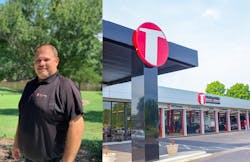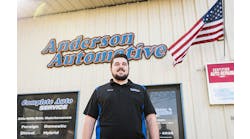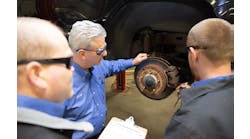SHOP STATS: Thomas Tire & Automotive Location: 8 in North Carolina (Highpoint, 2 in Asheboro, Aberdeen, Archdale, Burlington, Greensboro, Randleman) Operator: Sally Thomas Average Monthly Car Count: 700 to 2,200 Staff Size: 227 company-wide Number of Lifts: 6 to 15 Annual Revenue: $14 million (retail locations only)
“To be a good leader or owner, you need to seek wise counsel. You have to have the leadership among even your managers and different operations in the business, which helps the owner make great decisions that can grow the business.”
That’s what Glenn Williamson of Thomas Tire & Automotive believes it takes for a business to reach its goals. After winning the Ratchet+Wrench All-Star Award in the shop manager category in 2017, it was apparent co-owner and president, Sally Thomas, was doing something right, and giving her managers more responsibility at her stores is her way of doing so.
Doing this has increased the business from one to now eight retail locations, and $14 million in annual revenue, not including the two commercial locations and quick lube.
“I know so many different owners that keep a lot of things close to the chest, whether it’s their financials, how the company is performing—I am the exact opposite,” Thomas says.
The Backstory
Developing and empowering managers has always been a priority for Thomas Tire. Williamson trained under Sally’s father, Paul Thomas, when he started at the shop as a 15-year-old. When training his employees, Paul had the mentality of giving managers more responsibility within the business. That’s how Williamson started his track to gaining more leadership in his management job. After working in every position imaginable the past 30 years, he became a manager in 2012 and started running the Asheboro location.
The Problem
Although developing managers was not a new practice, when Thomas took over operation, she knew she wanted to take it to another level and also create a system that was uniquely hers. While Paul had each location compete against one another to have differentiators, Thomas believed it was important to work with the other stores instead and to compete against their actual competitors. For the business, she believed this created individual goals, when in reality the company should have one consistent goal together.
Thomas wanted to create a culture of true synergy and teamwork and has been working toward that goal for the past six years as co-owner and president, along with her brother, Bryan, running all of the business’ locations across central North Carolina.
The Solution
Since Thomas has managed the locations, she has always believed in growing opportunities for her employees. This started out with giving managers more responsibility in managing their own shops, so she could focus on the bigger picture.
Thomas gives her managers the freedom to run their location and, essentially, be the face of their location.
“We really promote an ownership mentality with all of our managers,” Thomas says. “I don’t like the word manager—I really see them as leaders.”
Thomas attributes her method to the way the Chick-fil-A franchise does things: she gives them direction on what she wants but lets them take the reigns from there. To get to this point, Thomas says the managers are given the autonomy to be able to make decisions on their own. Yes, they are given guidelines and structure with some policies and procedures that will help them along the way, but it’s the manager’s final say on what goes, allowing them to take care of the customer at whatever cost.
If other shop owners want to start giving their managers more responsibility, Thomas says it first comes down to complete transparency.
“Everybody knows what our goals are. I give them everything that they need in order for them to know what to do with their business,” Thomas says.
When Thomas has a new manager, she spends four to five hours going over everything in the business. From there, she lets the managers take the reins on running their location.
“There’s a lot of trust there,” Williamson says. “She provides the vision.”
To make sure the shops are meeting goals, Thomas holds monthly meetings with all of her managers. She says this is a time to check-in on any issues, and for the managers to have an open forum for new ideas, strategies, and goals.
Managers get their P&Ls at these meetings, but also have the backup to support it. Thomas uses the data platform Domo to show statistics to her employees on where they are and what they need to focus on to better their locations.
“When you combine transparency with data, it’s really powerful,” Thomas says. “Every dollar that gets booked to their store, they have the backup that supports it.”
The Aftermath
Because Williamson took over responsibilities and was trusted to do the best job, Thomas is now able to focus on the bigger picture things, which she says is the “financial success and the success of our people.”
At the beginning of 2019, Thomas tasked him with a new role: training coordinator. With this new initiative, Thomas wanted to have skilled laborers and have training processes that translated to all of the locations the same way. Williamson helped create the program.
“When it came to putting the training program together, she just gave me an idea and I took it and ran with it,” Williamson says.
The company has been able to grow the store from four retail stores back in 2012 to soon-to-be eight retail stores.
“If she had not allowed us to have the opportunity to [lead], there’s no way we could have grown to what it is in a six, going on seven, year period,” Williamson says.
Thomas says the auto repair industry is notorious for hiring someone, throwing him or her in with no training, adopting a sink-or-swim mentality, and then growing frustrated when the employee sinks.
Thomas decided she wanted to keep growing the company and wanted to staff her stores with people who have worked for her before, and who also know the company philosophies and culture. The program allows there to be a clear career path, starting off being a tech, to hopefully someday running his or her own shop.
The training program is ongoing and is meant to build your career with the company. Once you have met all of the requirements in a certain area, you are able to apply to shift up, which then moves an employee into another training platform for the new, higher position.
The program has partnered with community colleges and programs in order for high schoolers and college students to be able to come through as an apprentice, with Glenn running the whole program and training them.
“Glenn is a teacher by nature,” Thomas says.
She says he was the most ideal candidate, as he has held every position in the place and has excelled at everything he has ever done.
The Takeaway
Overall, trust is a big part of leadership, and giving your staff leadership opportunities helps everyone involved—managers, owners, even customers.
When it comes from a customer perspective, the manager is now the face of the location he or she visits, which leads to building better relationships with their customers and invoking trust with them, too.
And while managers focus on the customers and day-to-day operations, Thomas is able to focus on the bigger picture of the overall business, growing new locations and her staff into lifetime employees and learners.



